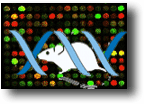 Key challenges for biology in the twenty-first century are the exploration of the structure and the dynamics of the complex inter- and intra- cellular web of interactions that contribute to the structure and function of a living cell. In this context and towards that end, we are implementing and integrating a variety of functional genomics (reverse genetics, expression profiling and bioinformatics) methods and tools in holistic, multidisciplinary explorations of pathogenetic mechanisms. In this context research @VART focuses on two pillars:
Key challenges for biology in the twenty-first century are the exploration of the structure and the dynamics of the complex inter- and intra- cellular web of interactions that contribute to the structure and function of a living cell. In this context and towards that end, we are implementing and integrating a variety of functional genomics (reverse genetics, expression profiling and bioinformatics) methods and tools in holistic, multidisciplinary explorations of pathogenetic mechanisms. In this context research @VART focuses on two pillars:
- Molecular and genetic dissection of pathogenetic mechanisms in the development of pulmonary fibrosis
- The role of ATX and LPA signalling in embryonic development, pathophysiology and cancer